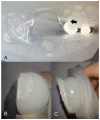Is Modular Dual Mobility Superior to Standard Bearings for Reducing Dislocation Risk after Primary Total Hip Arthroplasty? A Retrospective Comparative Multicenter Study
- PMID: 37445235
- PMCID: PMC10343014
- DOI: 10.3390/jcm12134200
Is Modular Dual Mobility Superior to Standard Bearings for Reducing Dislocation Risk after Primary Total Hip Arthroplasty? A Retrospective Comparative Multicenter Study
Abstract
Background: Dual mobility (DM) has been proven to reduce dislocation risk after total hip arthroplasty (THA). In the last decade modular DM (modDM) constructs have been introduced to allow the use of DM articulation with standard cementless acetabular shells. However, clinical evidence of modDM effectiveness is still low in primary THA and concerns about implant-related complications are increasing. This retrospective comparative multicenter study is aimed to investigate if the dislocation rate after primary THA could be reduced with modDM in comparison to standard bearing (SB).
Methods: 262 THAs were performed between 2017 and 2019, using SB (129 hips) or modDM (133) with the same cementless highly porous modular acetabular cup. Dislocations, complications and revisions were recorded and implant survival was analyzed.
Results: At 2.5-year mean follow-up, dislocation occurred in 4 hips (3.1%) within the SB group while intraprosthetic dislocation in 2 hips (1.5%) within the modDM group (p = 0.44). Implant survivals with revision due to dislocation were 95.2% and 95.9% at 4-year follow-up for SB and modDM, respectively (p = 0.50).
Conclusions: modDM used in primary THA might reduce dislocation rate in comparison to SB, even in high-risk patients, however, caution is advocated due to specific intraprosthetic dislocation.
Keywords: dislocation; intraprosthetic dislocation; modular dual mobility; standard bearing; total hip arthroplasty.
Conflict of interest statement
Lorenzo Banci is employed as a clinical researcher at Permedica Orthopaedics. All other authors declare no conflict of interest in relation to the present research.
Figures






References
-
- Australian Orthopaedic Association National Joint Replacement Registry (AOANJRR) Hip, Knee & Shoulder Arthroplasty: 2022 Annual Report. AOA; Adelaide, Australia: 2022. [(accessed on 8 May 2023)]. pp. 1–487. Available online: https://aoanjrr.sahmri.com/annual-reports-2022.
-
- Bousquet G., Gazielly D., Girardin P., Debiesse J.L., Relave M., Israeli A. The ceramic coated cementless total hip arthroplasty. Basic concepts and surgical technique. J. Orthop. Surg. Tech. 1985;1:15–28.
LinkOut - more resources
Full Text Sources

